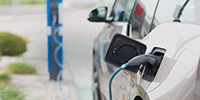Ultimate Guide to Deep Cycle Battery Terminology
|
With such a large number of deep cycle battery terms out there, it can be difficult to decipher what everything means. We’ve put together an extensive list of over 40 common terms, with easy to understand descriptions and examples. Using our simple reference guide, you’ll always have the knowledge available at your fingertips to help you compare, understand and demystify any information on deep cycle batteries. The guide is broken up into a few main areas, and the terms that relate to each (as well as other common names that mean the same thing). You can select a heading below to jump to that section. General Terminology | Battery Types | Battery Ratings/Specs | Battery Construction | Battery Damage General TerminologyDepth of Discharge (DOD) Depth of Discharge (often abbreviated to DOD or D.O.D) is the percentage amount of a deep cycle battery’s capacity that you drain, before charging it back up again. Example: if you have a 100AH Capacity Battery and you drain it down to 70AH, this would be a 30% DOD. Cycle A cycle is the process of discharging a deep cycle battery and then recharging it to full. One cycle means that the battery is discharged and then recharged once. Deep cycle batteries are typically rated to a certain number of cycles at a depth of discharge. Example: A battery might be rated to perform 1650 cycles at 30% depth of discharge. This means that the battery should withstand being discharged 30% and then recharged to full 1650 times. Internal resistance Internal resistance is how much a battery “resists” energy flow. Lower is better, allowing charging and discharging at more efficient rates. Most of the loss in charging and discharging batteries is due to internal resistance, and the lost energy is then converted to heat (which is why batteries get hot when they are charging). Many factors can affect internal resistance such as battery age and sulfation. State of charge The percentage of capacity that your battery is at. Typically this can be worked out by measuring battery voltage when there are no loads or draws on the battery. Example: AGM Battery at approx. 12.7 volts is 100% fully charged (AKA 100% state of charge), while an AGM battery at 10.5 volts is entirely discharged at 0%. Battery TypesAGM (Absorbed Glass Mat) In the battery’s internal construction, there is a fine fiber glass mat between each of the internal plates. This mat absorbs the acid in the battery, so that there is no liquid acid that can leak even if the battery is damaged. This provides several advantages such as long service life, maintenance free design, and no gassing off. Gel (Gelled Electrolyte), Flat Plate Gel Gelled batteries contain acid, but the acid is turned into a gooey gel form by the addition of silica gel. This means that the batteries won’t leak acid even in broken, similar to AGMs. However, there are some disadvantages compared to AGMs, such as not being able to be charged at as high a rate, and being less forgiving if overcharged. Tubular Gel Unlike standard flat plate gel batteries, tubular gel batteries use special tubular plate design that provides a large increase in performance. These batteries are typically used for long life power storage solutions due to extremely high service life and cyclic life. Unlike standard 12V batteries that contain 6 individual cells within a single battery, tubular gel usually only contain a single 2V cell in each battery, which further increases reliability. Flooded, Wet Cell Flooded batteries have free flowing liquid acid inside the battery, and are the opposite of AGM or Gel style batteries. This method of construction is typically used in automotive batteries, but it can also be used in deep cycle battery applications, however these will not last nearly as long their AGM or Gel counterparts. VRLA (Valve Regulated Lead Acid), SLA (Sealed Lead Acid) VRLA and SLA refer to batteries that are entirely sealed, without requiring any water or acid to be added. They can be used to describe either flooded style batteries that are sealed, or AGM/Gel batteries without liquid acid. Typically these batteries are maintenance free, will not leak acid, and also feature a safety release valve which will release gas in an emergency situation if there is excessive internal pressure. High Discharge High discharge implies that the batteries allow a greater flow of current than standard batteries. This is ideal for situations with high current draws such as operating winches or electric motors. Automotive, Starting, SLI Typically used to start an engine, these batteries are not suitable for deep cycle use and will quickly fail if used for this purpose. Automotive batteries are built to offer a high cranking capacity to kick over an engine, and this only uses a very small portion of the battery capacity before it is recharged. This is why an automotive battery will last a long time in a vehicle, but not if you discharge reasonable amounts of power from it regularly. Marine Marine batteries are as the name implies, designed for marine purposes such as running electronics on a boat. They are a hybrid style battery that can start a boat motor with a reasonable cranking capacity, but also have deep cycle capabilities. Typically this battery is built in a fully sealed flooded acid construction. Calcium A calcium battery basically means that calcium has been added to the construction of the battery. Calcium lowers the internal resistance, allowing for a higher cranking capacity. Calcium batteries typically refer to automotive batteries, but can also rarely be used in other battery types. Lead Acid This term basically implies that the battery uses lead plates and acid as the chemical components that power it (compared to other chemistry types such as lithium or nickel-cadmium). The majority of deep cycle batteries available are lead acid, including AGM and Gel. Battery Ratings/SpecificationsService life Batteries store power using a chemical reaction, and service life are how long the chemical components that make up this reaction are estimated to last. The service life provides a “hard cap” to the maximum amount of time a battery can last, regardless of how it is used. Once the battery reaches the service life, the internal chemistry will start to fail and the battery will no longer operate. Cyclic Life The number of cycles that a battery can tolerate is known as the cyclic life. Typically batteries will be rated to perform a number of cycles at a certain depth of discharge. Once reaching that number, the battery should still be usable, but it will have degraded to about 80% of its original capacity. The number of cycles a battery can perform is directly related to how deep you discharge the battery each time (the Depth of Discharge), because performing deep discharges regularly shortens the lifespan of the battery significantly. Example: Wisdom Power 125AH AGM Deep Cycle Battery is rated to ~1650 cycles at 30% depth of discharge, but only ~300 cycles at 100% depth of discharge. Battery Capacity, Amp hours (AH) Battery capacity is measured in Amp Hours (AH). Using this capacity, you can roughly work out how long your battery will last by finding out the Amp Hour draw of whatever you are going to run off the battery. Example: a 100AH Deep Cycle Battery running a fridge with a 5AH draw would last about 100/5 = 20 hours before going completely flat. However, it is recommended not to drain the battery that low. Capacity Hr Rate, Hour Rate, C Rating While battery capacity is in AH, it is also rated at a certain hourly rate. This is because the capacity of a battery changes depending on quickly you are discharging it. Example: Discharging a battery with a steady 5 amps/hr draw, the battery lasts 20 hours. This means that the battery is rated to 5x20 = 100AH at 20hr rate. Using the same battery with a higher draw of 8.5 amps/hr, the battery only lasts 10 hours. This means that the battery is rated to 8.5x10 = 85AH at 10hr rate. To accurately compare capacities of battery they must be measured at the same hour rating. Most deep cycle batteries in Australia follow a standard 20hr rate (sometimes shown as C/20), or a 100hr rate for off grid scenarios. Nominal Voltage Simply put, this means “named” voltage, and is basically an easy way to categorize any batteries within a standard voltage range. This is because the voltage of deep cycle battery actually fluctuates depending on its construction and use. Example: A 12V Nominal voltage battery could actually be measured at 11V, 12.2V, 14V, etc. but to easily categorize them, we just call them all 12V. Charge voltage This is the recommended voltage to charge the battery at. Different batteries charge at different rates, such as flooded batteries charging at a higher voltage than AGM. It is important not to charge a battery above its charge voltage, as this will overcharge the battery and cause damage. Discharge Rate The discharge rate of a battery is the amount of power you are draining at any one time (usually measured in amps). If you have a particularly high amount of power you are trying to draw in a short amount of time, it’s important to make sure that the battery you are using can support this rate. CCA (Cold Cranking Amps), MCA, CA Cold cranking amps is the maximum amount of amps that a battery is able to release on a cold start. This is typically used for starting engines in vehicles, as the engine will draw a high rate of amps over a short period of time to start the vehicle. Self Discharge Rate All batteries slowly lose power over time, even when they aren’t being used. The self discharge rate is the percentage of capacity that the battery will lose when it is in storage. Typically batteries like AGM or Tubular Gel will only lose a couple of percent capacity per month, while other batteries can lose over 10%. This is important when working out how often you need to provide a maintenance charge on batteries when they aren’t in use. Battery ConstructionChemistry Batteries store energy by utilizing a chemical reaction inside the battery. The type of reaction depends on the chemicals used within the battery. Examples of a chemistry type are Lead Acid, Lithium, or Nickel-cadmium. Plates Part of the internal construction of a battery, the plates are large sheets of metal (usually lead). There are two kinds of plates, positively charged and negatively charged. Grids Grids are metal sheets similar to plates, but instead of being solid they have a grid pattern, allowing gaps within the plate where material can move through. Cells A battery cell is the combination of plates, grids, and other components (such as the glass mat in AGM batteries) all combined into a single unit. Each cell is typically rated at 2 volts, and multiple cells are combined into a single battery (6x2V cells = 12V battery). These cells are then immersed in the acid within the battery, or absorb the acid in the case of AGMs. MF (Maintenance Free), Non-spillable Maintenance free batteries are entirely sealed and will not leak acid or require water to be added. These terms go hand in hand with VLRA/SLA. Safety Valve Sealed batteries work by recombining hydrogen gas within the battery over and over, meaning that they don’t need to release this gas. However, in some situations the gas will build up to an unsafe level (such as if the battery is overcharged), and the battery would eventually explode if the pressure wasn’t released. For this reason, sealed batteries have a safety valve that will allow the gas to release in emergency situations to prevent explosion. Terminal The terminal is where you connect to the battery. Automotive batteries typically have a post style terminal, whereas deep cycle batteries have bolts of varying sizes. Battery DamageSulfation During battery use, sulfate crystals form inside the battery as a by-product of the chemical reaction. When the battery is charged again, these crystals are removed. However, if the battery is left in a discharged state and not charged for some time, these crystals become permanent. This reduces the active material within the battery, decreasing battery capacity and performance. Gassing, Venting, Gassing off If the safety valve of a battery is activated to relieve pressure, hydrogen gas will escape from the battery into the outside air. This process is knowing as “gassing off”, and typically happens when the battery has been overcharged. Accompanied by the gas release is foul smell. If gassing off happens, the battery performance will be reduced as some of its chemistry has been lost by the gas leaving the battery. Overcharge When a battery is charged at too high a voltage, or continually charged even when it is at full capacity, it will become overcharged. This can cause the battery to swell in size and gas off, reducing capacity and potentially creating a dangerous situation. Undercharge If too low a charge voltage is applied to a deep cycle battery, the current flow will slowly trickle away and basically stop before the battery reaches full charge. Over time this will eventually reduce capacity due to small amounts of lead sulfate remaining on the electrodes. Thermal Runaway If a battery is significantly overcharged, it may cause a dangerous situation called thermal runaway. This is where the battery is progressively heated up from the overcharge, and as it gets hotter it will accept more current, heating it up even further. Eventually catastrophic failure will occur such as meltdown of the cell, explosion or fire. |













